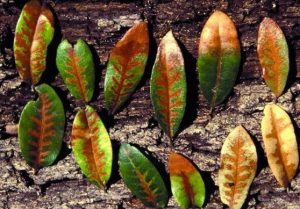© 2012-2020 guy leblanc all rights reserved
Oak wilt is a very complex disease. This information is only intended to address how oak pruning impacts the spread of the disease. Central Texas is considered the area most

seriously affected in the United States. This is due in large part to the prevalence of live oaks here, and the propensity for root grafting which this species has. It has been recognized by researchers and expert arborists that the vast majority of the spread of oak wilt occurs underground, from live oak to live oak, through these grafts. New infection centers can become established when spores are carried to fresh, unpainted wounds on healthy oaks. In Texas, these spores only come from red oaks, which create spores on what are called fungal mats.
Live oaks and red oaks are the most susceptible species in central Texas. Post oaks oaks and other white oak family species have very low susceptibility. In red oaks, oak wilt is nearly always fatal. Live oaks can hang on for years after infection, in uncommon incidences even appearing to overcome the disease.
In an attempt to suppress the disease, various government agencies have published overly simplified recommendations which have unfortunately been misinterpreted over the years. In order to correct this, Guy organized a group of representatives from the International Society of Arboriculture, the Texas Forest Service, and the Texas A&M AgriLife Extension Service, which in 2011 co-published in these guidelines for oak pruning.
Some key things the general public should be aware of (which are referred to in the guidelines) are:
- There are many sources of wounds that can potentially be an invasion point for the oak wilt fungus, including construction damage, wind, hail, rubbing branches, and animals such as birds, squirrels and insects. All of these are the source of literally thousands of wounds, very often in the spring. If oak wilt was as virulent as the general public often thinks, we would probably have few oaks left by now.
- Although there is a recognized increase in susceptibility in the spring, branches that are at risk of rubbing against buildings or against each other, or being hit by vehicles should be removed as soon as they are found, regardless of the time of year, as stated in the new guidelines. This is because when done properly, removing such branches probably reduces oak wilt risk.
- Calendar-based dates cannot reflect actual temperatures and humidity, which play a crucial role in insect activity and fungal spore development. For instance, in central Texas there are often many consecutive days in February and sometimes March in which it is too cold for insects to fly. Likewise in June it is often too hot for fungal spores to develop. This is why knowledgeable local arborists do not rely on calendar dates as guidelines.
- Because the oak wilt fungus does not grow on dead tissue, dead branches are not an invasion point for the disease, and can be removed at any time. Dead branch removal cuts should be painted if there is a chance that any live tissue is exposed.
These newest guidelines take some of the above information into consideration and clarifies that pruning to eliminate injury to branches, or as necessary for property protection or personal injury protection, as well as to remove dead branches can be done at any time of year, but I would say that during the spring time months, it should only really be done by competent, qualified arborists (see my choosing an arborist page.)
Competent arborists have known and adjusted for these facts for decades, and safely pruned oaks throughout the year. It is critically important that it be done judiciously, however. That is what makes hiring a Certified Arborist like Guy LeBlanc important. When the work is being done personally by someone with the level of experience he has, you know the tree care you are receiving is the best possible.
For more on this, see my January 2012 blog post and search YouTube for my Central Texas Gardener appearance from that month in which I discuss oak wilt (video correction: post oaks can get oak wilt- see above).
For initial consultation, call
5one2 301 8700.
